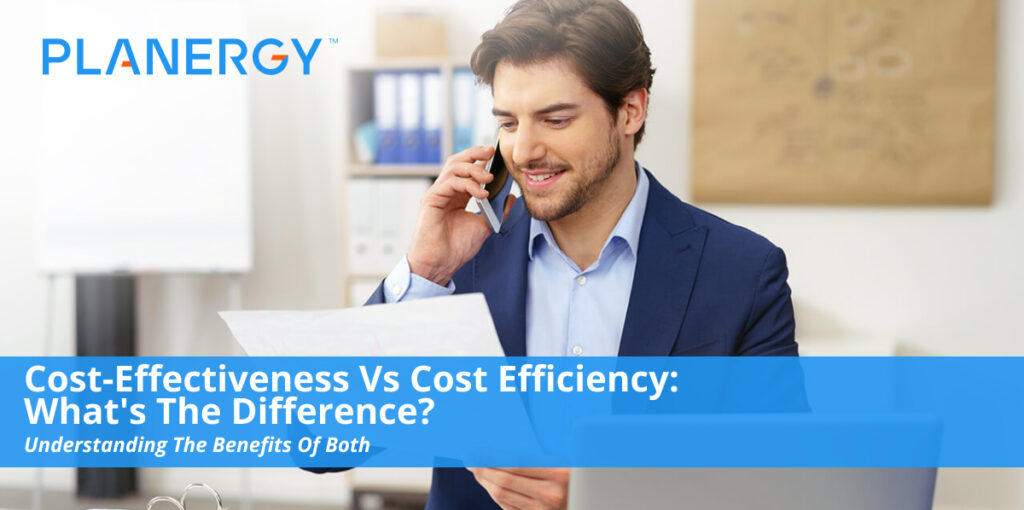Though cost-effectiveness and cost-efficiency are two similar terms often used interchangeably, the reality is that they are two different concepts.
Both are important to your success as a business – whether startup or enterprise.
Too much emphasis on one often leads to a lack of emphasis on the other. When these things are not in balance, your business can suffer.
By understanding the fundamentals of cost-effectiveness vs cost-efficiency, you can keep your business running as smoothly as possible.
What is Cost-Effectiveness?
According to Dictionary.com, effective is an adjective that means, “Adequate to accomplish a purpose; producing the intended or expected result.” It is cost-effective, even when costs are high when you are pursuing the right goals.
To improve cost-effectiveness, consider the following:
Centralize labor. Take time to review your company positions on a regular basis and eliminate redundancy. If you have too many duplicate positions, it can be a drain on your budget. You can also look for areas to employ automation to reduce the overall labor costs.
Find where you can save money on your inventory. It’s no secret that inventory is a huge expense for a lot of businesses. However, it’s also one of these areas to reduce spending.
Companies have to manage their materials wisely by reducing the amount through improved inventory control measures including economic order quantity. Using these controls minimizes the total spent by checking on the variable cost that can and occur when holding inventory.
Organizations have to consider setup costs, demand rates, and holding costs, to properly perform inventory analysis.
Develop a cost management program. It’s crucial to have a specific program that allows your company to analyze and employ cost-saving strategies. Implementing a high-quality high-return strategy is next to impossible if you don’t have visibility into the way the entire company spends and can effectively maximize their budget.
This may mean optimizing your supply chain methodology to take advantage of options to lower your costs through domestic sourcing and other methods.
Build a strong IT infrastructure. Develop and maintain efficient forms of automation how to reduce your high.
Investing in high-quality production machinery, labor tracking software, enterprise resource planning software, and other forms of automation.
Though this may seem like a heavy initial investment, automation quickly provides a large return.
Want to be sure your efforts are paying off? Use a Cost-Effectiveness Analysis or CEA. This form of economic analysis is often used in the health care industry because it provides a way to look at the costs and the outcomes of one or more interventions.
In terms of health economics, it helps us see how much money we can save with certain treatment options, given the cost of illness on the economy.
This is crucial information for developing health policy and determining what necessary health services should be provided for free or at a low cost.
A CEA looks at the outcome. and compares the cost of an activity to the cost of the outcome. FOr instance, if you have a control group of 100 women, out of which 25 participate in prenatal care. You want to measure the cost effectiveness of a one-on-one outreach program compared to a mass text messaging campaign.
Out of 100 women in the outreach, 42 attended prenatal care, for 17% more compared to the control. Out of 100 women in the mass text messaging, 31 attended prenatal care, for 6% more than the control.
Even though the outreach seems more effective, when you consider the cost is $3500, the program spent $206 for each woman who attended prenatal care. The mass texting program costs only $700, for a cost of $117 per woman.
Therefore, the better solution for public health would be to invest more time and energy in the text messaging program rather than the one-on-one. Moving the allocation of funds from the one-on-one program to the text messaging program could yield better results overall.
What is Cost Efficiency?
Dictionary.com defines efficiency as, “performing or functioning in the best possible manner with the least waste of time and effort.” It is cost-efficient when costs are low when you’re pursuing the wrong goals, but not losing a lot of money in the process.
He is about saving money by making a product or performing an activity in a better way. You can measure cost efficiency by monitoring the ratio of the output produced to the cost incurred. You can also measure cost efficiency by the revenue generated against the expenses incurred.
To improve cost efficiency, consider:
- Switching to more affordable suppliers, who won’t cause quality issues
- Using automation to speed production
- Use SaaS solutions rather than on-premise solutions – the same thing for a lower cost in most cases
- Taking steps to reduce overall incremental costs.
Similar to a CEA, health care also uses cost-utility analysis (CUA) with incremental costs to determine the feasibility of recommendations.
If the trade-off doesn’t provide a reasonable increase in the quality of adjusted life-years (QALY), then economists and policy-makers aren’t likely to recommend treatment as a preventive measure.
When something is effective it is about doing the right things. When something is efficient it’s about doing things right. You may be paying more but you will be getting the right final result when you focus on cost effectiveness.
The Difference
When something is effective it is about doing the right things. When something is efficient it’s about doing things right.
The ultimate place for a business to be is both effective and efficient – where you are pursuing the right goals and running cost-efficiently. You’re getting a high return on your investment, and costs are efficient.
In terms of costs, let’s look at it like this:
Imagine you’re about to purchase a used car. You’ve got $10,000 to work with, and want to buy it outright. Of course, the dealer may try to entice you to buy something more expensive using the $10,000 as a down payment. But, you don’t want the hassle of a loan.
Car A is newer but has more miles. Car B is older, with a couple of small dents, but has less mileage overall and a more meticulous maintenance record. Car A is priced at about $1,000 more, right at 10K. Both have the same fuel efficiency.
Which one do you buy?
The effective choice lies not in the fuel efficiency or the price itself. It lies in the total cost of ownership. At first glance, you’d think that because car A is newer it’s an effective solution. But once you realize it hasn’t been maintained as well, and that the parts are more expensive, it’s no longer the better of the two options.
Plus since Car B is priced at $9K, you can use that remaining $1K to pay for tax, tag, and title, so you drive off not a penny over budget. With Car A, you pay the $10K price tag “on budget” but still have to deal with those extra costs to make your vehicle legal to own and operate.
See why what seems effective isn’t always efficient? Both vehicles fit into the budget, technically. But one is more likely to run into expensive repair costs down the road, simply because there are more miles and a lack of maintenance records.
Why It Matters
Typically, businesses aim to increase and improve the efficiency of their operations and sales processes. When you’re working with limited resources, it makes sense to maximize the use of each of the resources from technology to budget, time, and sales rep.
However, by pursuing efficiency no matter what, some companies missed the valuable chance to step back and look at their overall effectiveness.
When businesses are pursuing the right goals and being efficient, they’re making proper use of technology, not wasting time, and have better alignment and collaboration between team members.
Many organizations have their hearts in the right place because they know the goals they want to achieve, many of them are inefficient when it comes to achieving those goals.
Other companies run like a tight ship where all employees work together and remain focused on a task. But the problem comes in when the task at hand isn’t aligned with the correct goal.
Let’s take a closer look at the differences between activity effectiveness and activity efficiency.
Your sales team likely has a daily, weekly, monthly, and quarterly goal, that when achieved, represents the effectiveness of the role.
If your sales team reps are expected to make 70 calls every day, and they easily hit that number, they are effective at their job. Some of them may even be able to go above and beyond to make nearly 100 calls a day.
But what if those calls are producing fewer connections and even fewer closed deals? That’s where efficiency ratios come in.
For sales managers, having reports that track how many calls lead to connections and how many connections and how many demos lead to close deals can serve as a powerful indicator of which reps are not only effective at their job but also efficient in performing it.
Therein lies the problem. Is it more important for your organization to pursue Effectiveness or efficiency? if you’re trying to grow and have the resources to move through, optimizing Effectiveness may be the answer for you.
But, if you’re a smaller company with very limited resources, it may be more important to pursue efficiency. This approach maximizes your capabilities and prevents you from stretching yourself too thin.
That’s why it’s important for your company to find the “Sweet Spot” between efficiency and effectiveness.
The spot the works for your company may not be the same spot that works for another, but finding the balance that works for your company should be your ultimate goal.
Cost-Benefit Analysis
In trying to strike the right balance between cost-effectiveness and cost-efficiency, a cost-benefit analysis (CBA)can be helpful. It is a systematic review process companies use to analyze which decisions to make in which to let go of.
The cost-benefit analyst summarizes the potential rewards expected from an action or situation and then subtracts the total costs associated with taking that action. Some analysts are consulted also build models to assign a dollar value to intangible items such as the benefits and costs associated with living in a certain town.
For instance, rent may be really expensive in one area, but if jobs are plentiful and transportation is readily available, it’s not really an issue.
But if you come across a town where rent is expensive, public transportation is lacking, and jobs barely pay over minimum wage, then the cost of living is high. That means someone making the same amount of money but living elsewhere would be able to afford to live a better quality of life on the same salary.
A CBA involves measurable financial metrics like cost saved or revenue earned as a result of the decision to pursue a particular project. A CBA may also include intangible benefits costs or effects from the decision such as customer satisfaction and employee morale.
Ultimately, the CBA outcome is used to determine whether a project is financially feasible or if the company should switch gears to another option.
In many CBA models, the CBA will also factor in at the opportunity cost. Opportunity cost provides alternative benefits that may have been realized when choosing one alternative over another.
The opportunity cost is the missed opportunity as a result of a decision or Choice factor in factoring in opportunity cost allows project managers to weigh the benefits from alternative half instead of focusing on just the current path or choice.
By considering all options and the potential missed opportunities, the CBA is more thorough and makes for better decision-making.




